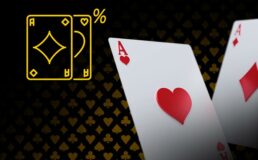Texas hold ’em is the most popular poker variant played in casinos and online poker sites. And one of the most important things to know about Texas Hold ’em is knowing the odds of making hands.
Knowing the poker pair odds of certain hands will help you boost your chances of winning. Read on to learn more about pairs and their implied odds.
HOW TO PLAY A PAIR HAND?
 The odds for a one pair represent the likelihood that a pair of cards will be dealt in a poker hand. Most pairs are fairly rare, with the top-of-the-line A-A being the least likely. It’s important to understand the probability of forming each pair.
The odds for a one pair represent the likelihood that a pair of cards will be dealt in a poker hand. Most pairs are fairly rare, with the top-of-the-line A-A being the least likely. It’s important to understand the probability of forming each pair.
A big mistake is compounding your losses when one pair fails to materialise by overplaying it. The simple rule when forming a pocket pair hand is if it fails to pair up, it’s time to fold.
You can calculate the odds per hand or use the advice of an expert to understand your chances of receiving a pair.
Keep in mind that the odds only increase when playing more hands. With some luck, knowledge, and experience, you can quickly become an expert at forming a pair.
WHAT ARE THE ODDS OF GETTING A PAIR IN POKER?
A one pair hand forms when a poker player obtains two cards of the same rank. The odds of a player receiving a pair are as follows.
There is a 32.43% chance of obtaining a pair when two cards are dealt and a 45.15% chance of completing a pair when four cards are dealt.
When betting on Texas hold ’em, the chances of making pocket pairs are much greater due to the presence of five community cards as well as two hole cards. This increases the odds to roughly 42% of making a pair, while players betting on Heads Up Poker can expect a pair around 57% of the time.
As poker is a game of luck, these odds can change rapidly depending on the cards that are dealt and other players in the game.
WHAT ARE THE IMPLIED ODDS OF A PAIR?
 As discussed previously, the odds are the chance that a particular hand will be dealt to a player or a group of players.
As discussed previously, the odds are the chance that a particular hand will be dealt to a player or a group of players.
Usually, this percentage is determined by figuring out the non-equivalent pairs among the ranks of all the cards in the deck. The odds of pairs can vary due to other factors, such as the number of players, the number of cards drawn, and the size of the deck.
Generally, the higher the pairs of cards, the lower the likelihood of any given player or group of players receiving them.
Implied odds are an extension of this, referring to the odds that an opposing player is holding a given pair of cards. This can give players a better idea of their chances of winning in a given situation, allowing them to make a more informed decision.
CHANCES OF HITTING A FLOPPED PAIR
Hitting a pair on the flop may be a bit of a challenge, but the odds of flopping a pair are higher than the odds of flopping two pair poker hands or three pair poker hands.
Assuming you’ve been dealt unpaired hole cards, there is a 12% chance of hitting a pair on the flop in a cash game, translating to one in 7.5 odds. This is unless you’re trying to hit a specific pocket pair, in which case your odds may vary. But we’ll get into that later.
WHAT IS THE PROBABILITY OF GETTING A PAIR AS A STARTING HAND?
The probability of getting a pair in poker all depends on the starting hand. There are 3,744 possible starting hands in Texas hold ’em, of which only 78 are pairs. Therefore, the chance of getting a pair is 2.1% or one in 46.7.
The probability of getting pocket aces (A-A) as a starting hand is 0.45% or one in 221. Playing multiple hands at a time increases the chances of forming a pair.
Also, the chances of making a pair are significantly increased when playing non-hold ’em variants such as Omaha or Razz. Therefore, the odds of forming a pair vary drastically depending on which table you’re betting on.
WHAT ARE POCKET PAIRS IN POKER?
Pocket Pairs (or Pocket Rockets as they’re sometimes called) are a type of starting hand where the two cards a player is dealt are both of the same rank. For example, 8-8, J-J, K-K (pocket kings), and Q-Q (pocket queens) are all pocket pairs.
Pocket pairs offer great potential for a strong hand across the board, as they are only typically only beaten by higher pairs or rarer combinations such as a flush draw (one card short of a full flush), an inside straight/ open-ended straight draw, a three-of-a-kind, and, of course, a royal flush.
TYPES OF POCKET PAIRS
Of course, the different pocket pairs you can earn can be split into different categories:
- Premium Pocket Pairs
Premium hands, also known as big pocket pairs, are probably the best preflop hands you can be dealt when you play poker as they are quite strong. These include two jacks, two queens, two kings and two aces.
The value of these hands increase significantly as the number of players betting decreases — you’re less likely to get out-flopped by one player.
- Medium Pocket Pairs
Medium pocket pairs include hands ranging from 10-10 to 7-7. With these pairs, it is recommended to try and get heads-up when entering the flop stage.
These hands can win against a singular opponent even without flopping a set, but your odds decrease against multiple players.
- Small Pocket Pairs
Small pairs include hands ranging from 5-5 to 2-2. Small pairs are the hardest hands to play as they might have good potential when hitting the right flop, but that kind of flop is not super common.
THE ODDS OF A POCKET PAIR IN POKER
The odds of being dealt a pair are approximately 5.88%, which means there will be one pocket pair for about every 17 hands.
With such odds, understanding your pocket pair’s strength and making the right decisions with them is paramount.
WHICH PAIR HAS A HIGHER CHANCE OF WINNING?
If two players go head-to-head with two pairs, the player with the higher card combo will take the win. So, a premium pocket pair is more likely to win than a small pocket pair.
PAIRS IN POKER OR A STRAIGHT FLUSH — WHICH IS BETTER?
A pair in poker is by far the most popular form of hand and is usually the first hand players look out for when playing poker. A pair of cards require two cards of the same rank.
A straight flush, on the other hand, is much harder to attain, as it requires five cards of the same suit and in numerical order. This hand has a one in 72,193 chance of occurring.
It’s safe to say that a straight flush is better than a pair in terms of strength, but you are more likely to earn a pair than a straight flush.
This same argument can also be used in relation to a full house, royal flush, three-of-a-kind, flush, and two pair, for example.
CONCLUSION — LEARN THE NUMBER OF POSSIBLE PAIR MATCHES IN POKER
Poker pocket pair odds give players the knowledge and understanding of their overall likelihood of hitting a specific pair in their hand. With this knowledge, players can adjust their strategy and risk more or less depending on the given odds of their hand.
No matter what pocket pair they earn, players need to properly strategise to utilise it to its fullest potential. Play smart and take advantage of knowing the odds of a pair!
If you want to read more articles, visit our blog.
FAQ
✅ WHAT ARE THE ODDS OF HITTING A TWO PAIR IN POKER?
The probability of hitting a two pair when you play is 0.0475 or 4.75%. The odds of flopping two pair hands are 2% when starting with unpaired hole cards.
✅ WHAT TO DO WITH HIGH PAIRS IN A HAND?
Keep them! Higher pairs are stronger and more likely to win. That is unless you can make room for stronger combos.
✅ WHAT ARE THE ODDS OF HITTING PAIR ON THE TURN?
There is a roughly 12.8% chance of hitting a pair on the turn.
✅ WHAT ARE THE ODDS OF HITTING A PAIR ON THE RIVER?
The chances of hitting a pair on the river is about 13%.
✅ CAN I PLAY POCKET PAIRS AT LV BET CASINO?
Yes! Put your knowledge to the test at one of our various tables.